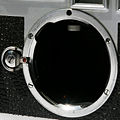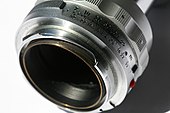 Leica M3 and M Mount 50mm lens | |
| Type | Bayonet |
|---|---|
| External diameter | 44 mm |
| Tabs | 4 |
| Flange | 27.8 mm |
| Connectors | Focal lens indicator for frame selection in the viewfinder |
The Leica M mount is a camera lens mount introduced in 1954 with the Leica M3, and a range of lenses. It has been used on all the Leica M-series cameras and certain accessories (e.g. Visoflex reflex viewing attachment) up to the current film Leica M-A and digital Leica M11 cameras.
Contents
- Overview
- M Mount camera bodies
- Film cameras
- Digital cameras
- Other manufacturers
- M mount lenses
- Other manufacturers 2
- See also
- References
- External links
This lens mount has also been used by Epson, Ricoh, Minolta, Konica, Cosina Voigtländer, Rollei, Carl Zeiss AG and Rollei Fototechnic on some of their cameras. [1]


























